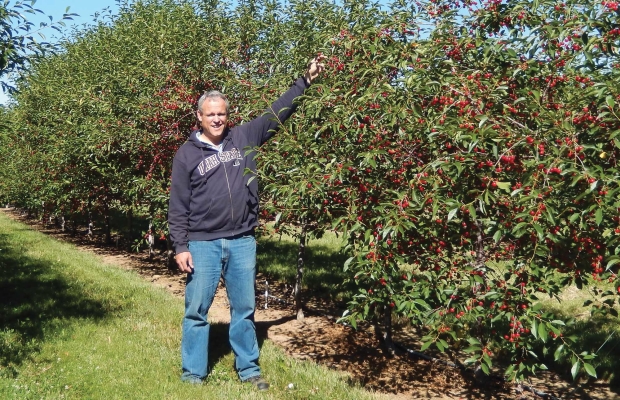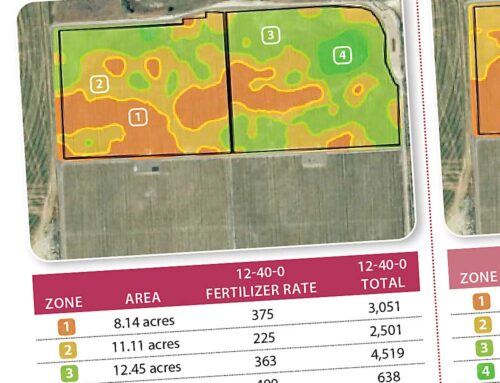
Brent Black says trees need to be kept small enough to fit into the throat of an existing berry harvester.
(Courtesy Brent Black)
For a few years now, there’s been a movement of sorts to change tart cherries from a tree fruit to a berry.
A few growers have followed the movement, and some tart cherries have been successfully harvested with over-the-row
berry harvesters also used with raspberries, blueberries, haskaps, and saskatoons.
About 15 years ago, Dr. Bob Bors began the work of breeding bush-size tart cherry trees and harvesting them with a berry harvester on the northern Canadian prairie at the University of Saskatchewan.
He has several varieties that are now commercially available, and growers there are adding cherries to make a trio of fruit—tart cherries, saskatoons, and haskaps—harvestable by the same machine in three separate seasons.
Then, less than a decade ago, work began at Michigan State University, when Dr. Ron Perry located several growers willing to plunge ahead and experiment with planting, pruning, and harvesting Montmorency tart cherries from trees sized and shaped to fit into the throat of a berry harvester.
About the same time, Dr. Brent Black began work with high-density tart cherry systems at Utah State University.
Utah doesn’t have a large fruit industry, but about half the industry is devoted to desert production of Montmorency tart cherries like those grown in Michigan, Washington, Oregon, New York, and Wisconsin.
Black credits a tart cherry research symposium organized by Dr. Jim Flore at Michigan State University with turning his attention toward high-density tart cherries.
Black spoke to tart cherry growers during the Northwest Michigan Orchard and Vineyard Show in Traverse City in January. Most of them were dismayed to find they knew nothing about this researcher or his work, which could affect their region where half of the nation’s tart cherries are grown.
High density
Black wants to bring to tart cherries the same advantages that apple growers obtained when they moved to high-density plantings. He envisions growing tart cherries in a continuous hedge, like blueberries, but thinner, like a fruiting wall.
“The tree has to fit existing harvesters,” he said. The blueberry harvester he works with has catching plates at the bottom where fruit drops after being shaken from the bushes by a rotating spindle with fingers that are agitated by a cam drive.
The trees enter a tunnel that is 7.3 feet tall and 3.7 feet wide. The shaker height can be adjusted by about two feet, so at the highest setting, the tunnel is 10.5 feet high, with trunk space of 3.1 feet at the bottom. With a shorter trunk, the tree height would have to be shortened so the tree is about 8.5 feet tall.
One setback to his work came when Blueberry Equipment Inc. (BEI) ceased manufacturing operations last year. Over-the-row work is based on a similar machine built under the Korvan name by Oxbo.
Advantages
Some of the reasons Black sees for moving this direction include:
—Equivalent or higher yields. Tart cherry orchards now need lots of alley space around trees to move the trunk shakers and catching frames.
Alleys can be narrowed and trees planted closer together. Trees can be shorter, but less open space is needed at the bottom of the tree.
In his test plots, he has planted trees 4, 6, 8, and 10 feet apart in rows 13 feet apart. “Thirteen feet is too far,” he said. “We’ll need alleys maybe 10 feet, or even closer.”
Utah growers shoot for higher yields than growers elsewhere, wanting around 10,000 pounds per acre. Last year, with yields at that level in his test plantings, the cherry volume overwhelmed the berry harvester, something that needs to be addressed, Black said.
—Higher quality. Tart cherries tend to bear in an outer shell around an open center and need good light exposure to develop large fruit with high soluble solids and intense color.
In Utah, he said, growing conditions can push Brix levels to 20˚, well above the 15˚ more typical in other regions. Since dried cherries and juice are now major products and increasing in volume, growers who can obtain high Brix and good color should be rewarded for that.
“We may need a payment system that rewards high soluble solids fruit to drive the shift to high density systems,” he said.
—Earlier returns. Growers now wait up to six years for the trunks to become large enough for the trunk shakers used in harvesting. Growers could harvest fruit in the second and third leaf in the over-the-row system.
—Labor savings. Working with shorter, simpler trees should trim pruning costs. Over-the-row harvesting should be comparable in speed with shaking.
—Crop load management. Currently, tart cherry growers do very little to manage crop load, but crop load is related to quality. Black thinks that in a high-density system they may be able to use pruning and mechanical thinning.
—Tree life. Trunk shakers are hard on trees.
Challenges
In its natural form, the Montmorency tree is moderately sized. The cherry is unusual in that its color is light, bright red and the flesh is clear yellow. “We have no plans to change the cultivar,” Black said, since it is clearly the industry standard.
It is usually grown on Mahaleb rootstock, but new rootstocks are available that control size and vigor. Black has plantings that include Mahaleb as well as Gisela 3, 5, and 6. “It will be hard to maintain trees in the space allotted if we have to use Mahaleb,” Black said.
Dr. Amy Iezzoni, the tart cherry breeder at Michigan State University, has named five new cherry rootstocks that Black also wants to test.
Black does not want to see tart cherry growers having to use the techniques high-density apple growers use, such as building trellises or bending and tying limbs.
He wants to adapt the spindle approach around a permanent central leader with renewal pruning and stub cuts used to encourage more fruit to grow near the leader.
Bevel (or Dutch) cuts, used with apples, don’t work well with cherries as the trees don’t break new buds. Stub cuts 5 to 10 inches long do break buds and bear fruit, he said.
He also thinks that multiple leaders may have a place. He plans to test trees in which single trunks have two or four main leaders trained in a palmette shape to fill the space between trees but not allow limbs to extend into the alleys.
The number of leaders could be chosen based on the need to control vigor. The two-leader tree splits off from the main root at about 20 inches above the ground. The four-leader tree has a second set of two branches above the first two, in a candelabra shape.
At Michigan State, Ron Perry believes tart cherry growers have been captured by history. A labor crisis in the Bracero program in the 1960s drove them to adopt limb shakers, and then trunk shakers, over a very short period in which other possible choices were not tested.
In Poland, he said, the need to replace labor for harvest developed more gradually, leaving them open to trying other harvest options. They went to over-the-row harvesting. •






Leave A Comment